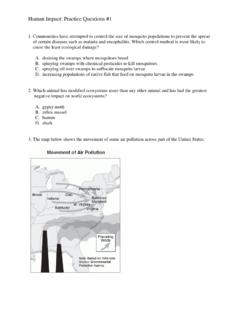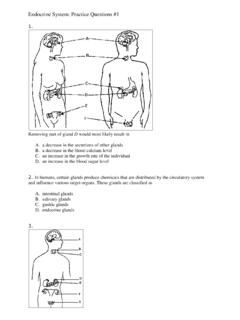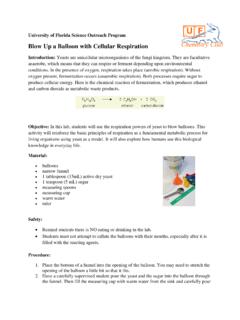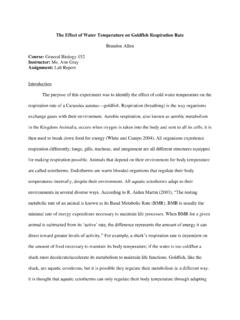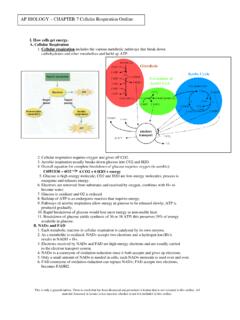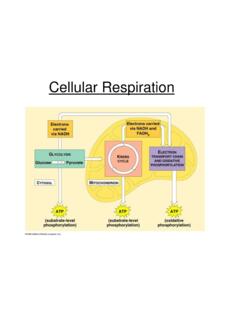Transcription of Cellular Respiration: Practice Questions #1
1 Cellular respiration : Practice Questions #1. 1. Which statement best describes one of the events taking place in the chemical reaction ? A. Energy is being stored as a result of aerobic respiration . B. Fermentation is taking place, resulting in the synthesis of ATP. C. Energy is being released for metabolic activities. D. Photosynthesis is taking place, resulting in the storage of energy. 2. The main result of aerobic respiration is the A. conversion of radiant energy into chemical energy B. production of lactic acid as an end product C. storage of energy in a polysaccharide D. production of ATP from the breakdown of glucose 3. Which substance is needed for aerobic Cellular respiration to occur? A. oxygen B. carbon dioxide C.
2 Nitrogen D. methane 4. Which process is represented by the arrow in the diagram? A. growth B. respiration C. regulation D. excretion 5. The diagram shows a mitochondrian. All the arrows are associated with the process of A. carbon fixation B. photochemical reaction C. synthesis D. aerobic respiration 6. The diagram shows a mitochondrian. Letter X most likely represents A. ATP. B. maltose C. lactic acid D. PGAL. 7. The energy found in ATP molecules synthesized in animal cells comes directly from A. sunlight B. organic molecules C. minerals D. inorganic molecules 8. In the demonstration shown in the diagram, which process performed by the peas when they start to grow causes the drop of liquid to move to the left? A.
3 Protein synthesis B. photosynthesis C. digestion D. Cellular respiration 9. ATP is a compound that is synthesized when A. chemical bonds between carbon atoms are formed during photosynthesis B. energy stored in chemical bonds is released during Cellular respiration C. energy stored in nitrogen is released, forming amino acids D. digestive enzymes break amino acids into smaller parts 10. Information concerning a metabolic activity is shown below. Substance X is most likely A. DNA. B. oxygen C. ATP. D. chlorophyll 11. The graphs below show the changes in the relative concentrations of two gases in the air surrounding a group of mice. Which process in the mice most likely accounts for the changes shown? A. active transport B.
4 Evaporation C. respiration D. photosynthesis 12. Which statement best describes Cellular respiration ? A. It occurs in animal cells but not in plant cells. B. It converts energy in food into a more usable form. C. It uses carbon dioxide and produces oxygen. D. It stores energy in food molecules. 13. Base your answer to the question on the diagram below and on your knowledge of biology. The diagram illustrates a process by which energy is released in organisms. Cells usually transfer the energy that is released directly to A. Glucose C. Oxygen B. ATP D. Enzymes 14. Base your answer to the question on the diagram below and on your knowledge of biology. The diagram illustrates a process by which energy is released in organisms.
5 14. The energy released in this process was originally present in A. sunlight and then transferred to sugar B. sunlight and then transferred to oxygen C. the oxygen and then transferred to sugar D. the sugar and then transferred to oxygen 15. Which part of a molecule provides energy for life processes? A. carbon atoms B. oxygen atoms C. chemical bonds D. inorganic nitrogen 16. The diagram below represents a biochemical process. Which molecule is represented by X? A. DNA. B. starch C. protein D. ATP. 17. A biological process that occurs in both plants and animals is shown below. Which row in the chart below identifies the lettered substances in this process? Row A B C D. A. O2 CO2 glucose enzymes B. glucose O2 enzymes CO2.
6 C. enzymes O2 CO2 glucose D. glucose CO2 enzymes O2. 18. In heterotrophs, energy for the life processes comes from the chemical energy stored in the bonds of A. water molecules B. oxygen molecules C. organic compounds D. inorganic compounds 19. The production of energy-rich ATP molecules is the direct result of A. recycling light energy to be used in the process of photosynthesis B. releasing the stored energy of organic compounds by the process of respiration C. breaking down starch by the process of digestion D. copying coded information during the process of protein synthesis 20. In what way are photosynthesis and Cellular respiration similar? A. They both occur in chloroplasts. B. They both require sunlight.
7 C. They both involve organic and inorganic molecules. D. They both require oxygen and produce carbon dioxide. Answer Key: 1. C. 2. D. 3. A. 4. B. 5. D. 6. A. 7. B. 8. D. 9. B. 10. C. 11. C. 12. B. 13. B. 14. A. 15. C. 16. D. 17. B. 18. C. 19. B. 20. C.



